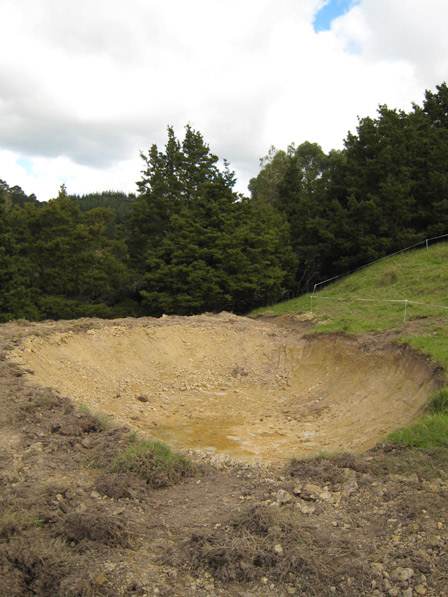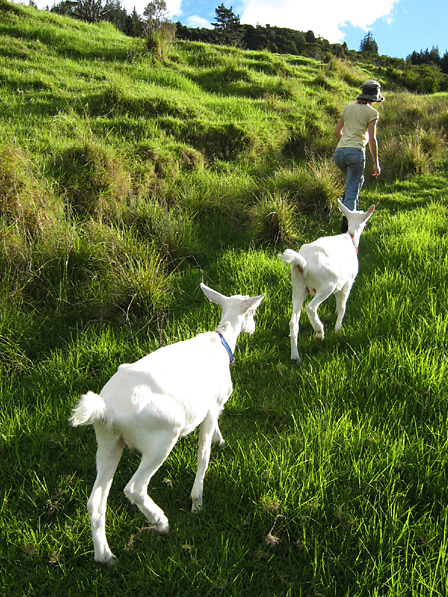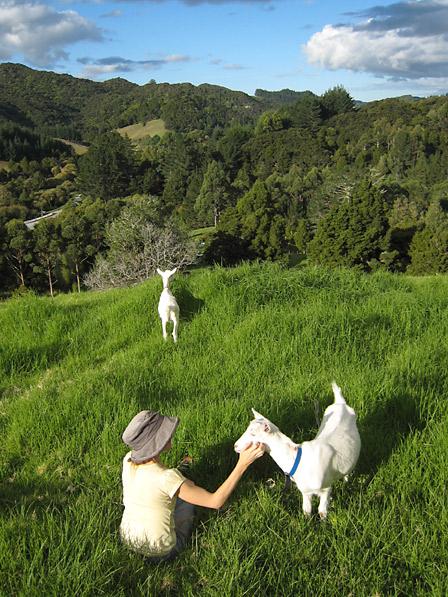Now that we have some kefir grains, we decided it was time to follow the recommendations of some of our readers and try making kefir cheese.
Iowerth wrote:
Make your kefir cheese much as you would make yogurt cheese:
First make your kefir. Then, strain out the grains, and place the kefir in a porous container such as a cloth bag or a large paper coffee filter (as we did, supporting it with an old coffee filter holder) so that the whey can be collected as it drips out.
Cover and place your kefir in the fridge and in about day, after which the whey should have all dripped out, you have kefir cheese. Add some salt and herbs (to taste) to your cheese and enjoy.
This sounded simple enough to us. . . and so it was. The kefir cheese was delicious mixed with a bit of sea salt and some herbs from the garden. We enjoyed it on top of pieces of sourdough toast.

Kefir cheese on sourdough toast
I’ve also been making another tasty treat using kefir cheese. I found a recipe for “Cheese Pucks” in the Summer 2006 edition of “Wise Traditions” — a publication put out by the Weston A. Price Foundation. The ingredient list looks a bit unlikely, and the name “cheese pucks” made me wonder if the results would be tooth-breakingly hard. I nearly didn’t try this recipe, but I’m very glad I did! The resulting “cheese pucks” are rich, cheesy and somewhat chewy in consistency. If you want to try the recipe, please note that I find I need to add extra arrowroot powder to get the dough into a suitable consistency to roll. Of course, that might be because I substitute kefir cheese for the cream cheese called for in the recipe! I also think that the recipe tastes extra good with a few chives or sprigs of fresh dill snipped into the mixture. The recipe is gluten free, but if you don’t do well on cooked dairy, or don’t want to destroy the live properties of the kefir by cooking it, then it’s probably not for you.
A couple of days ago, we also had our first attempt at making quark. Our neighbours along the road, and some Farmlet readers, have been telling us how easy it is to make. . . and how delicious!
Anita wrote:
I usually let two liters of raw milk stand in a stainless steel pot, lid slightly ajar, for two to three days at room temperature. When the natural souring process is complete, I skim the fresh soured cream off the top, which keeps well in the fridge, but usually gets used quickly in salad dressings, soups and sauces. The skimmed cheese gets poured in a cheesecloth lined bowl and hung for two hours or longer, depending on how wet or dry I want the cheese. Some of the whey gets used for fermenting veggies (our favorites are ginger carrots), some for pre-soaking beans and grains, but the bulk goes to the chickens who love it. The fresh cheese (we call it Quark in German) can be used in a variety of ways, but our absolute favorite is as a dessert. I use a puree stick to blend the cheese smooth and add raw honey, linseed oil and raw milk to get a creamy dessert that is just delicious with fresh or frozen berries.
Kevin and I have been wanting to try making quark for a while! A few days ago we had a couple of extra litres of raw milk, so we decided to give it a go. Mysteriously, we have ended up not with quark and whey, but with several litres of yoghurt. Somehow that milk must have become innoculated with yoghurt culture, though we have no idea how! The milk was handled carefully and soured in a clean stainless steel pot. Our neighbour laughed in disbelief when I confessed that our first quark effort had produced yoghurt. She says she’s never met with such an outcome in all her years of making quark. We will have to try making quark again soon. In the mean time, we have a large additional batch of yoghurt to enjoy. Not a bad consolation prize, though we were really looking forward to trying the quark! I’m about to start a big batch of yoghurt dough, in anticipation of making empanadas in the next day or so.









